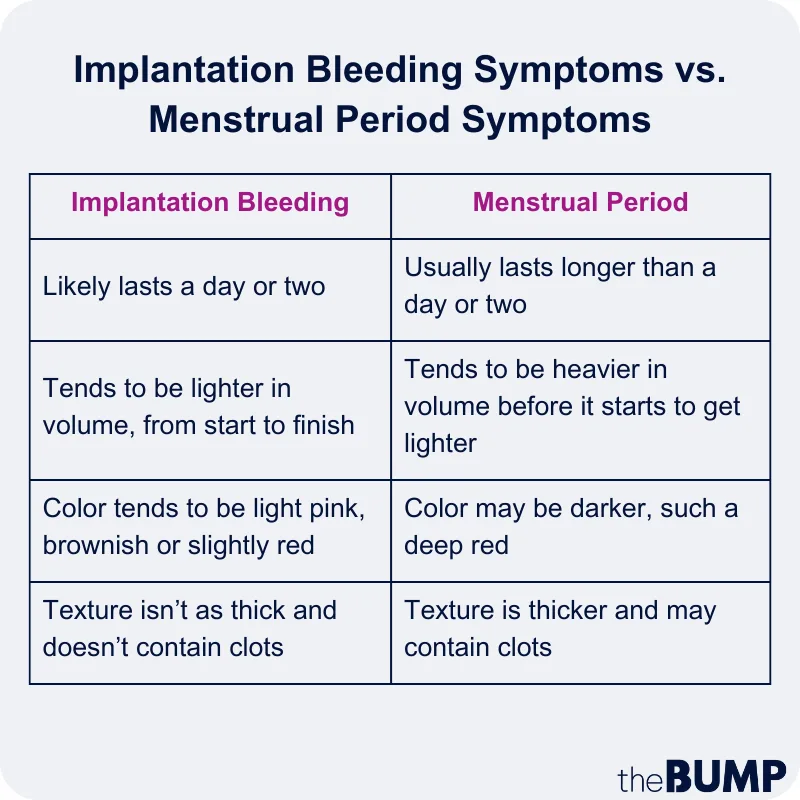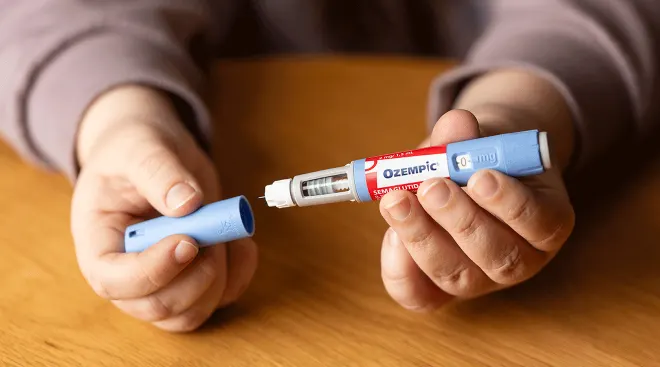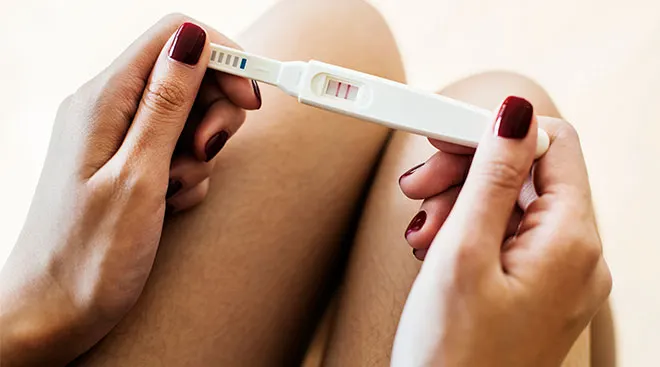Implantation Bleeding: When It Happens and What It Looks Like
If you’re trying to get pregnant, you might be eagerly monitoring everything going on with your body—every cramp, every twinge, every slight deviation from the norm. And if you’re obsessively checking your underwear for signs of blood, know that you’re not alone. It’s stressful and exciting and totally overwhelming. Of course, it can be unnerving to see a streak of blood on your panties or after wiping, but don’t panic and assume you’re not pregnant if you notice a little spotting. Light, brief bleeding that lasts just a day or two can actually be a sign of early pregnancy. It’s known as implantation bleeding, and it can be a tip-off that an egg has successfully nestled into your womb. Suffice to say, you probably have a lot of questions—and we’re here to help. Want to learn how to recognize implantation bleeding, when it occurs, what it looks like and how you can tell the difference between this kind of bleeding and menstruation? Read on to get the full lowdown on implantation bleeding and what it may (or may not) mean, straight from the experts.
Implantation bleeding is a small amount of spotting or bleeding that happens after a newly fertilized egg burrows into the lining of your uterus. Since the uterine lining is rich with blood, some women spot a little at this point. This is totally normal and no cause for concern, but a pregnancy test and doctor’s visit may be in order to make sure implantation bleeding is truly the culprit (and not something else, like your period).
According to the American Pregnancy Association, approximately one third of women experience implantation bleeding in early pregnancy. All in all, there’s no real way to know whether spotting (or lack thereof) indicates pregnancy—only a test can tell. “Bleeding in the first trimester is common, although I would never say ‘normal,’” says Michael Cackovic, MD, a maternal fetal medicine physician at the Ohio State University Wexner Medical Center in Columbus. According to him, about 25 to 30 percent of women will experience some bleeding—including implantation bleeding—in the first trimester.
If you have no implantation bleeding, that’s perfectly normal too. “Don’t worry! It has no bearing on the success of your pregnancy,” says Julie Lamppa, APRN, CNM, a certified nurse midwife at Mayo Clinic.
If you’re checking your underwear every few hours in hopeful anticipation, you may be wondering: How soon after conception would you notice spotting? And when exactly does implantation bleeding occur? “Implantation bleeding may occur right around the time you think you may be getting your period,” Lamppa explains—which is why it can be confusing for those who experience it. “Some women will notice a small amount of spotting or bleeding about 10 to 14 days after fertilization of the egg,” she adds.
If you suspect you’re experiencing implantation bleeding, you’re likely eager to take a home pregnancy test—and stat. Not so fast, though. While there’s no harm in taking a test at this point, you’re better off waiting a few more days for the most accurate results.
According to the Cleveland Clinic, your body starts producing human chorionic gonadotropin (hCG) about 10 days after conception, which is around the same time implantation bleeding may occur. At this early stage in a healthy pregnancy, hCG levels double every two days. Still, it takes time for the hormone to build up in your system and reach a volume that can be detected by an over-the-counter urine test. Some tests may be able to detect hCG about 10 days after conception, but waiting until after a missed period can lower the chance of a false negative. Blood tests are more sensitive to hCG and can detect the hormone 9 to 12 days after conception.
How long can implantation bleeding last? It depends on the person, but some claim it lasts for one day, while others say three or four. Implantation bleeding can seem like a period, but it doesn’t last as long. Moreover, “you don’t continue to bleed like a normal period,” Lamppa says. So how much do you bleed during implantation? “It’s typically a small amount of spotting or bleeding,” adds Laurie MacLeod, APRN, CNM, a certified nurse midwife at Center for Women’s Health and Midwifery in New Haven, Connecticut.
Now that you understand what it is and when it occurs, you might be left wondering: What does implantation bleeding look like? The truth is, implantation bleeding can resemble a lighter version of your period; it’s not enough to warrant a feminine pad, but you might consider wearing a pantyliner just in case. Unfortunately, this can make it tricky to differentiate between implantation bleeding vs. your period.
How can you tell if it’s implantation bleeding or your period? Depending on how you typically experience menstruation, this could be a bit of a waiting game. But there are some ways to distinguish between the two:
-
Duration: Your period will typically last longer than implantation bleeding, MacLeod says. If you bleed for a day or two, it’s more likely to be implantation bleeding. If it stretches beyond that time frame, you may have gotten your period.
-
Volume: One of the most common questions asked: How heavy is implantation bleeding? It’s generally lighter than a menstrual cycle and shouldn’t fill a pad. “If you experience bleeding that’s considered to be heavy spotting or bleeding, that would be more than implantation bleeding,” Lamppa says. (But if you tend to have light periods anyway, you might not notice a huge difference.)
-
Color: The color of implantation bleeding is also usually lighter than a normal period. It’s usually pink or slightly red at the start, MacLeod says, although it can be brownish as the bleeding resolves.
-
Texture: The texture of implantation bleeding can vary, but it shouldn’t be overly thick. “It shouldn’t contain clots,” Lamppa says. Clots typically form with heavy bleeding, so if you’re truly experiencing implantation bleeding, you shouldn’t have them.
Ultimately, if you’re still not sure about whether you’re experiencing implantation bleeding or your regular period, the best course of action is to wait a few more days and take a pregnancy test.
Everyone will experience symptoms of implantation bleeding differently. Some may have no additional markers besides the light bleeding, while others may start to encounter a few early signs of pregnancy, MacLeod says. These can include:
But, again, don’t worry if you don’t experience these symptoms of implantation bleeding. “You may not have any associated pregnancy symptoms at this time because it’s still so early,” Lamppa says.
There are a lot of things that can cause bleeding during the first few weeks and months of pregnancy. “Causes of bleeding during early pregnancy can range from irritation to the cervix and vagina as blood flow is increased to the area, to threatened miscarriage or even ectopic pregnancy,” Cackovic says. If you experienced bleeding and you’ve gotten a positive pregnancy test, it’s important to see your doctor sooner rather than later to determine what’s going on.
“Your provider will assess how far you are into the pregnancy, the amount of bleeding you’re experiencing and if you’re feeling pain and other possible risk factors,” Lamppa says. “All of this information will help your provider figure out the next best steps for your care.”
Frequently Asked Questions
Can implantation bleeding be heavy?
As noted, implantation bleeding is usually fairly light and may even be lighter than your typical menstrual period. If your implantation is heavy, it could point to a different or underlying issue, notes Cleveland Clinic.
Can implantation bleeding be red in color?
You’ll likely have a lot of questions along the lines of: What color is implantation bleeding? And can it be red? Implantation bleeding tends to be on the lighter side, so while it may be slightly red in the beginning, it likely won’t ever become deep red the way a heavier period might.
Does implantation bleeding mean you’re pregnant?
Yes, implantation is one of the earliest signs of pregnancy, as it only occurs once the embryo burrows into the uterine lining.
Will a pregnancy test be positive during implantation bleeding?
Per Cleveland Clinic, the body really starts to produce hCG—the hormone that pregnancy tests look for—once implantation has been completed. For this reason, taking a pregnancy test during implantation can result in a false negative.
How long after implantation bleeding can I test for pregnancy?
While taking a pregnancy test during implantation bleeding may result in a false negative, the good news is hCG levels rise rapidly after implantation, so you’ll likely get accurate results for a take-home test a few days later.
What week of pregnancy is implantation?
According to the American Pregnancy Association, implantation bleeding can occur anywhere from 6 to 12 days after conception. While this is one to two weeks after conception, technically, pregnancy won’t begin until the embryo implants into the uterine lining.
When you’re actively trying to get pregnant, it’s natural to scrutinize the inner workings of your reproductive system and even compare your symptoms to those of others. But remember, you may have implantation bleeding (or you may not), and your experience may be different than someone else’s. The tricky part is determining if the spotting is actually the result of implantation or something else entirely (like your period). If you’re anxiously awaiting an answer, take a deep breath, monitor for additional bleeding and consider taking a test in a few days. Of course, never hesitate to reach out to your doctor with any concerns.
Please note: The Bump and the materials and information it contains are not intended to, and do not constitute, medical or other health advice or diagnosis and should not be used as such. You should always consult with a qualified physician or health professional about your specific circumstances.
Plus, more from The Bump:
Michael Cackovic, MD, is a maternal fetal medicine physician at the Ohio State University Wexner Medical Center in Columbus, Ohio. He is also an associate professor of medicine at Ohio State University. He received his medical degree from Drexel University College of Medicine in Philadelphia, Pennsylvania.
Julie Lamppa, APRN, CNM, is a certified nurse midwife at Mayo Clinic. She is a graduate of the University of Minnesota Medical School in Minneapolis, Minnesota.
Laurie MacLeod, APRN, CNM, is a certified nurse midwife at Center for Women's Health and Midwifery in New Haven, Connecticut. She received her Master's of Science in nursing, specializing in midwifery, from The University of New Mexico in Albuquerque, New Mexico.
American Pregnancy Association, What Is Implantation Bleeding?
Cleveland Clinic, Pregnancy Tests, November 2022
Cleveland Clinic, Implantation Bleeding, December 2022
American Pregnancy Association, Bleeding During Pregnancy
Learn how we ensure the accuracy of our content through our editorial and medical review process.
Navigate forward to interact with the calendar and select a date. Press the question mark key to get the keyboard shortcuts for changing dates.





















































